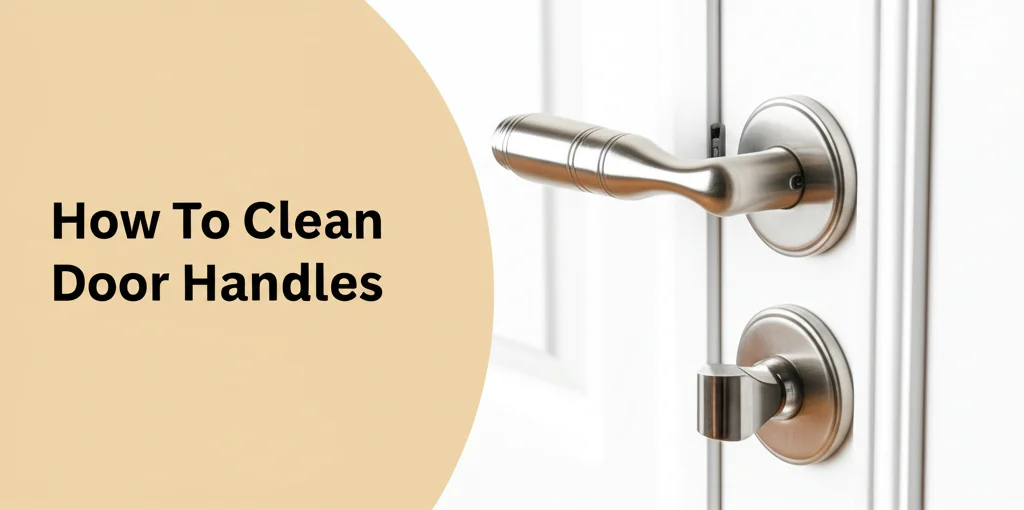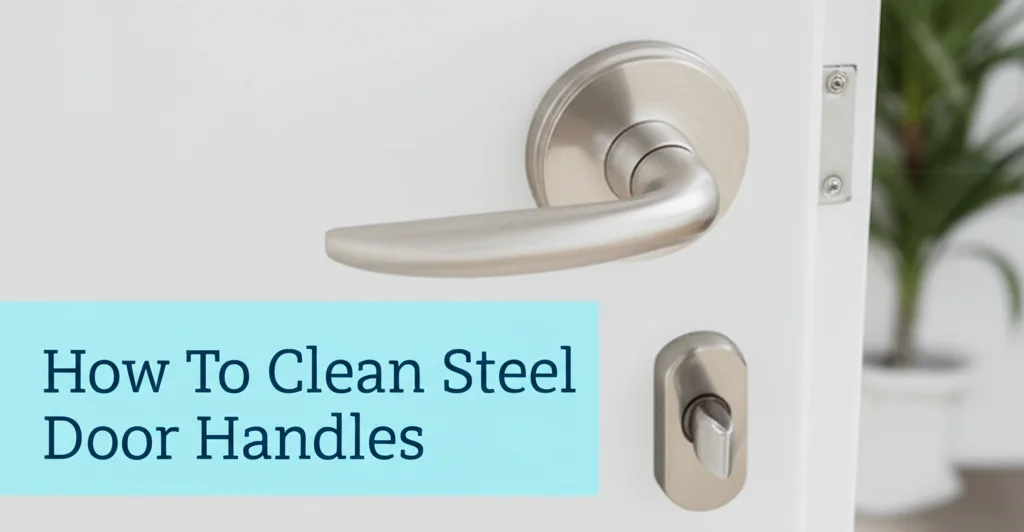· Home Cleaning · 7 min read
How To Clean Door Handles

Keeping Your Home Healthy: How To Clean Door Handles
Ever think about how many times a day you touch a door handle? It’s a surprising amount, and each touch transfers germs. Cleaning door handles isn’t just about appearances; it’s a crucial step in maintaining a healthy home. This article will guide you through everything you need to know about how to clean door handles, from choosing the right cleaning solutions to establishing a regular cleaning routine. We’ll cover different handle materials and offer tips for quick daily disinfection. Let’s get started and make your home a cleaner, safer space!
Quick Answer: To clean door handles, spray with a disinfectant cleaner (or a solution of rubbing alcohol and water), let it sit for a minute, then wipe clean with a microfiber cloth. Repeat regularly, especially during cold and flu season, to minimize germ spread.
Takeaway:
- Regularly disinfect door handles.
- Use appropriate cleaners for the handle material.
- Focus on high-touch areas in your home.
Why Cleaning Door Handles Matters
Door handles are high-touch surfaces, meaning they accumulate germs quickly. Think about it – everyone who enters or exits a room touches them. This makes them prime spots for bacteria and viruses to spread. Regularly cleaning door handles helps break the chain of infection, protecting you and your family from illness. It’s a simple habit that can make a big difference in maintaining a healthy home environment. Beyond health, clean door handles also contribute to a more welcoming and presentable living space.
Understanding Different Door Handle Materials
Before you start cleaning, it’s important to know what your door handles are made of. Different materials require different cleaning approaches. Using the wrong cleaner could damage the finish or even the handle itself. Here’s a breakdown of common door handle materials and how to approach cleaning them:
- Brass: Brass handles can be cleaned with a mixture of mild dish soap and warm water. Avoid abrasive cleaners, as they can scratch the surface.
- Stainless Steel: Stainless steel is durable but can show fingerprints easily. Use a stainless steel cleaner or a solution of vinegar and water.
- Nickel/Chrome: These finishes are relatively easy to clean with mild soap and water. Avoid harsh chemicals that can dull the shine.
- Wood: Wood handles require gentle cleaning. Use a damp cloth with a mild wood cleaner and dry immediately to prevent water damage.
- Glass/Crystal: These handles are delicate. Use glass cleaner and a soft cloth to avoid scratches.
The Best Cleaning Solutions for Door Handles
Now that you know your handle material, let’s talk about cleaning solutions. You have several options, ranging from homemade solutions to commercially available disinfectants. Here are some effective choices:
- Disinfectant Sprays: These are readily available and effective at killing germs. Look for sprays that list specific viruses and bacteria they eliminate.
- Rubbing Alcohol (Isopropyl Alcohol): A 70% isopropyl alcohol solution is a powerful disinfectant. Mix it with water in a spray bottle for a cost-effective option.
- Vinegar and Water: A 50/50 mixture of white vinegar and water is a natural cleaning solution that can disinfect and remove grime.
- Mild Dish Soap and Water: This is a good option for general cleaning and removing fingerprints.
- Hydrogen Peroxide: A 3% hydrogen peroxide solution can disinfect surfaces, but test it in an inconspicuous area first to ensure it doesn’t discolor the handle.
Step-by-Step Guide to Cleaning Door Handles
Let’s get down to the actual cleaning process. Here’s a step-by-step guide to effectively clean your door handles:
- Gather Your Supplies: You’ll need your chosen cleaning solution, a microfiber cloth, and potentially gloves (optional).
- Spray the Handle: Apply the cleaning solution generously to the door handle, ensuring it’s fully coated.
- Let it Sit: Allow the solution to sit for at least 30 seconds to a minute. This gives the disinfectant time to work. For stubborn grime, you might let it sit longer.
- Wipe Clean: Use a clean microfiber cloth to wipe the handle thoroughly. Pay attention to all surfaces, including the base of the handle where it meets the door.
- Dry the Handle: If necessary, use a dry microfiber cloth to dry the handle and prevent water spots.
- Repeat Regularly: Repeat this process daily or several times a day, especially during peak cold and flu season.
Deep Cleaning vs. Daily Disinfection
There’s a difference between a quick daily disinfection and a more thorough deep cleaning. Daily disinfection focuses on killing germs and removing surface dirt. Deep cleaning, on the other hand, involves removing built-up grime and restoring the handle’s shine.
- Daily Disinfection: Use a disinfectant spray or rubbing alcohol solution and wipe clean. This takes just a few seconds per handle.
- Deep Cleaning: Use a more targeted cleaner based on the handle material. You might need to scrub gently with a soft brush to remove stubborn grime. Polish the handle afterward to restore its shine. Consider deep cleaning your door handles monthly or as needed. If you’re looking for more ways to keep your home clean, you might want to check out https://www.beacleaner.com/how-to-clean-luxury-vinyl-plank-flooring/ for tips on maintaining your floors.
Preventing Germ Spread: A Holistic Approach
Cleaning door handles is a great start, but it’s just one piece of the puzzle. To truly prevent germ spread, consider a holistic approach to home hygiene. This includes:
- Regular Handwashing: Encourage everyone in your household to wash their hands frequently with soap and water.
- Ventilation: Open windows to improve air circulation and reduce the concentration of airborne germs.
- Surface Cleaning: Regularly clean other high-touch surfaces, such as light switches, countertops, and doorknobs.
- Disinfecting Common Areas: Pay extra attention to disinfecting common areas like the kitchen and bathroom.
- Consider Air Purifiers: Air purifiers can help remove airborne particles, including viruses and bacteria. If you’re dealing with stubborn grime on other surfaces, you might find https://www.beacleaner.com/how-to-clean-floor-grout-without-scrubbing/ helpful.
Frequently Asked Questions (FAQs)
- Q: How often should I clean door handles?
- A: Ideally, clean door handles daily, especially during cold and flu season. In lower-risk periods, cleaning a few times a week is sufficient.
- Q: Can I use bleach to clean door handles?
- A: While bleach is a powerful disinfectant, it can damage some door handle finishes. Avoid using bleach unless you’re certain it’s safe for the material.
- Q: What’s the best way to disinfect a wooden door handle?
- A: Use a damp cloth with a mild wood cleaner and dry immediately. Avoid soaking the wood with water.
- Q: Is rubbing alcohol safe for all door handle materials?
- A: Generally, yes, but it’s always a good idea to test it in an inconspicuous area first to ensure it doesn’t cause discoloration or damage.
- Q: How can I prevent fingerprints on stainless steel door handles?
- A: Use a stainless steel cleaner or a solution of vinegar and water. Wipe the handles frequently to remove fingerprints before they become noticeable.
- Q: Can I use a disinfectant wipe instead of spraying and wiping?
- A: Yes, disinfectant wipes are convenient and effective. Ensure the wipe is thoroughly applied to all surfaces of the handle.
Conclusion: A Small Effort, Big Impact
Cleaning door handles is a simple yet powerful way to protect your home and family from germs. By understanding the different handle materials, choosing the right cleaning solutions, and establishing a regular cleaning routine, you can significantly reduce the spread of illness. Remember, consistency is key. Make cleaning door handles a habit, and you’ll contribute to a healthier, more hygienic living environment. Don’t underestimate the impact of this small effort – it can make a big difference! If you’re looking for more ways to maintain a clean home, consider checking out https://www.beacleaner.com/how-to-remove-mold-from-painted-walls/ for tips on tackling mold issues.




